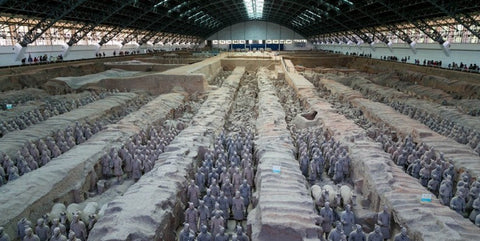Chinese Civilization

Chinese civilization is one of the oldest and most influential in the world, with a history that stretches back more than 5,000 years. Spanning thousands of years, it has shaped the way we think about culture, politics, and society. From ancient dynasties to the modern era, Chinese civilization has left an indelible mark on the world and continues to shape the way we live today.
So what is the history of this fascinating civilization?
According to legend, the Yellow Emperor (黄帝 Huáng Dì) , a mythical Chinese sovereign who reigned in the 27th century BC, is said to be the father of Chinese civilization as well as its first emperor. It was also during his reign that writing and Chinese martial arts were invented.

In terms of archaeological data, the earliest known Chinese civilization dates back to around 1600 BCE, with the emergence of the Xia Dynasty. This was the first of many dynasties that would rule China, each leaving its unique mark on the country's culture and history.
The Xia dynasty was followed by the Shang dynasty (1600–1046 BC), known for its advanced bronze metallurgy and the development of the first written Chinese language.

The next major dynasty was the Zhou dynasty (1046–256 BCE), which was marked by a shift from a tribal to a feudal society, with a centralized government and a system of lords and vassals. This dynasty also saw the development of Confucianism, which would become one of the most influential philosophies in Chinese history.
This was followed by the Qin Dynasty (221–206 BC), the first to unify China under a single ruler, Emperor Qin Shi Huangdi (秦始皇帝).
It was a time of great construction and engineering, with the building of the Great Wall of China and the creation of China's first road system.
Furthermore, it is to Qin Shi Huangdi that we owe the incredible mausoleum located near Xi An (North-West China), where he was buried, accompanied by thousands of terracotta warrior statues, on a site of no less than 56 square km.

The Han Dynasty (206 BC – 220 AD) was the next major dynasty, and it was during this time that China became a dominant power in East Asia. The Han Dynasty is also known for its scientific and cultural achievements, including the invention of paper and the development of the Chinese writing system.

Chinese civilization continued to evolve and transform over the centuries, with the emergence of new dynasties and the rise and fall of different kingdoms. The Tang Dynasty (618–907 CE) was known for its flourishing arts and culture, while the Song Dynasty (960–1279 CE) was marked by a period of economic and technological growth.
The Ming dynasty (1368–1644 CE) was a period of great naval expansion and exploration, with the voyages of Zheng He , who reached as far as Africa. The Qing dynasty (1644–1912 CE), the last imperial dynasty in China, was marked by a period of decline and foreign domination.
Chinese civilization has a rich and diverse history, with countless contributions to the world in the fields of art, science, and philosophy.

Today, China is a major global power, and its culture and history continue to shape the world in ways both small and large.

Click on the link below to discover the clothes designed by ARCHAIA CREATIONS that celebrate this incredible civilization!
